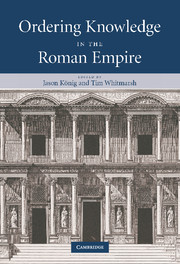Book contents
- Frontmatter
- Contents
- Preface
- Notes on contributors
- List of abbreviations
- Part I INTRODUCTION
- Part II KNOWLEDGE AND TEXTUAL ORDER
- 2 Fragmentation and coherence in Plutarch's Sympotic Questions
- 3 Galen and Athenaeus in the Hellenistic library
- 4 Guides to the wor(l)d
- 5 Petronius' lessons in learning – the hard way
- 6 Diogenes Laërtius, biographer of philosophy
- 7 The creation of Isidore's Etymologies or Origins
- Part III KNOWLEDGE AND SOCIAL ORDER
- Bibliography
- Index
3 - Galen and Athenaeus in the Hellenistic library
Published online by Cambridge University Press: 28 August 2009
- Frontmatter
- Contents
- Preface
- Notes on contributors
- List of abbreviations
- Part I INTRODUCTION
- Part II KNOWLEDGE AND TEXTUAL ORDER
- 2 Fragmentation and coherence in Plutarch's Sympotic Questions
- 3 Galen and Athenaeus in the Hellenistic library
- 4 Guides to the wor(l)d
- 5 Petronius' lessons in learning – the hard way
- 6 Diogenes Laërtius, biographer of philosophy
- 7 The creation of Isidore's Etymologies or Origins
- Part III KNOWLEDGE AND SOCIAL ORDER
- Bibliography
- Index
Summary
INTRODUCTION
The ordering of knowledge was a major issue for two writers of the late second and early third centuries ce. Athenaeus in his Deipnosophistae (Sophists at dinner) and Galen in a number of nutritional and pharmacological treatises set out to review the state of knowledge in the domain of food, nutrition and culture. The Galenic treatises under discussion here, although only a small part of his output, reflect important aspects of his research methodology; of the works of Athenaeus, only the Deipnosophistae survives. The Deipnosophistae and Galen's treatises on nutrition and pharmacology have in common not only a subject matter based on foods, drinks and medical treatises, but also an aim to research previous technical works and a strategy for cataloguing complex data. The data could be found by library-based research, and tested by experiment and personal experience. Once gathered, this data could be ordered in a list or catalogue, or other format. In this respect, Galen and Athenaeus resemble, for example, the lexicographer Pollux, some of the Hellenistic doctors, and others who produced catalogues in their own and previous centuries, although they apply those techniques rather differently from each other. Galen prefaces his works with chapters or whole books on methodology, while Athenaeus combines cataloguing with anecdote (for which compare Aulus Gellius and Aelian) and sympotic forms that resemble Plutarch's Sympotic questions.
The domains of food and pharmacology had become vast and complex by the second century ce.
- Type
- Chapter
- Information
- Ordering Knowledge in the Roman Empire , pp. 69 - 87Publisher: Cambridge University PressPrint publication year: 2007
- 2
- Cited by



